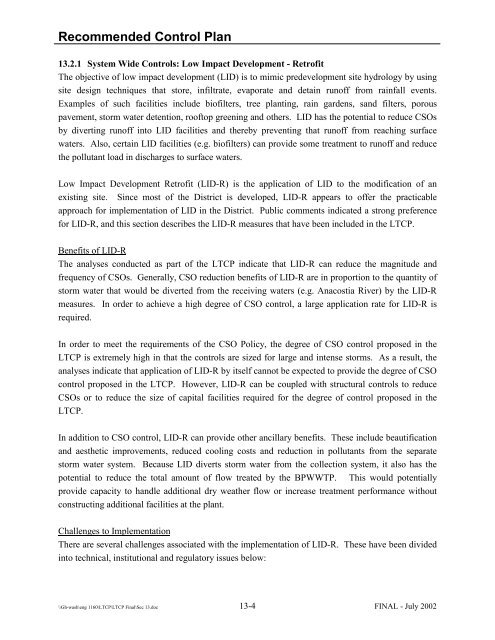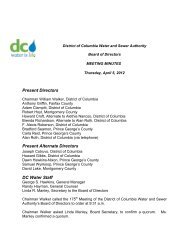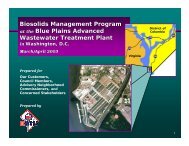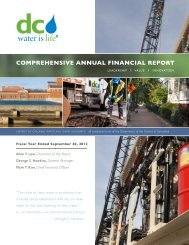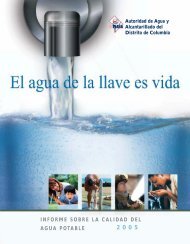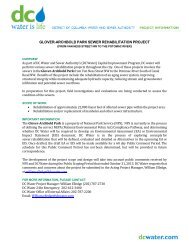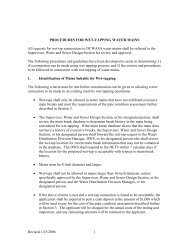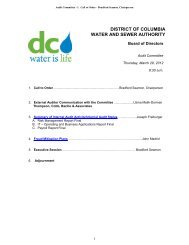- Page 1 and 2:
DISTRICT OF COLUMBIA WATER AND SEWE
- Page 3 and 4:
Acknowledgments The following Distr
- Page 5 and 6:
Table of Contents 3.2.1 Collection
- Page 7 and 8:
Table of Contents 9.6.1 Sensitive A
- Page 9 and 10:
Table of Contents SECTION 14 - WATE
- Page 11 and 12:
Table of Contents LIST OF TABLES Ta
- Page 13 and 14:
Table of Contents LIST OF FIGURES F
- Page 15 and 16:
Table of Contents LIST OF FIGURES F
- Page 18 and 19:
Executive Summary this condition, D
- Page 20 and 21:
Executive Summary relatively small
- Page 22 and 23:
Executive Summary Table ES-2 Recomm
- Page 25 and 26:
Executive Summary WASA would also b
- Page 27 and 28:
Executive Summary Table ES-3 CSO Ov
- Page 29 and 30:
Executive Summary Table ES-4 Compar
- Page 31 and 32:
Executive Summary 18% Figure ES -3
- Page 33 and 34:
Executive Summary Table ES-6 Cost I
- Page 35 and 36:
Executive Summary Develop compl
- Page 39 and 40:
Introduction 1.2 HISTORICAL BACKGRO
- Page 41:
Introduction CSOs. The inflatable d
- Page 44 and 45:
Introduction Public Participation
- Page 46:
Existing Conditions Table 2-1 Water
- Page 49 and 50:
Existing Conditions Table 2-3 Recei
- Page 51 and 52:
Existing Conditions The policy is b
- Page 53 and 54:
Existing Conditions during a single
- Page 55 and 56:
Existing Conditions 2.4.3 Use Attai
- Page 57 and 58:
Existing Conditions Government (not
- Page 59 and 60:
Existing Conditions Table 2-7 Compa
- Page 61 and 62:
Existing Conditions Anacostia River
- Page 63 and 64:
Existing Conditions Rock Creek As
- Page 65:
Existing Conditions be classified a
- Page 68 and 69:
Existing Systems NPDES Outfall No.
- Page 70 and 71:
Existing Systems Table 3-1 Summary
- Page 76 and 77:
Existing Systems Under the Intermun
- Page 78:
Existing Systems The capacities of
- Page 81 and 82:
Existing Systems Table 3-3 Inflatab
- Page 84 and 85:
Existing Systems 3.4.2 Existing Con
- Page 86 and 87:
Existing Systems 3.4.2.5 Control Of
- Page 88 and 89:
Sewer Systems Characterization Sect
- Page 90:
Sewer Systems Characterization 4.3
- Page 93 and 94:
Sewer Systems Characterization Tabl
- Page 95 and 96:
Sewer Systems Characterization At
- Page 97 and 98:
Sewer Systems Characterization Two
- Page 99 and 100:
Sewer Systems Characterization Para
- Page 101 and 102:
Sewer Systems Characterization Sinc
- Page 103 and 104:
Sewer Systems Characterization Wast
- Page 105 and 106:
Sewer Systems Characterization sele
- Page 107 and 108:
Sewer Systems Characterization Loca
- Page 109:
Receiving Waters Characterization S
- Page 112 and 113:
Receiving Waters Characterization 5
- Page 114 and 115:
Receiving Waters Characterization m
- Page 116 and 117:
Receiving Waters Characterization T
- Page 118 and 119:
Receiving Waters Characterization P
- Page 120 and 121:
Receiving Waters Characterization 5
- Page 122 and 123:
Pollutant Loads and Predicated Wate
- Page 124 and 125:
Pollutant Loads and Predicated Wate
- Page 126 and 127:
Pollutant Loads and Predicated Wate
- Page 128 and 129:
District of Columbia Water and Sewe
- Page 130 and 131:
District of Columbia Water and Sewe
- Page 132 and 133:
Screening of CSO Control Technologi
- Page 134 and 135:
Screening of CSO Control Technologi
- Page 136 and 137:
Screening of CSO Control Technologi
- Page 138 and 139:
Screening of CSO Control Technologi
- Page 140 and 141:
Screening of CSO Control Technologi
- Page 142 and 143:
Screening of CSO Control Technologi
- Page 144 and 145:
Screening of CSO Control Technologi
- Page 146 and 147:
Screening of CSO Control Technologi
- Page 148 and 149:
Screening of CSO Control Technologi
- Page 150 and 151:
Screening of CSO Control Technologi
- Page 152 and 153:
Screening of CSO Control Technologi
- Page 154 and 155:
Screening of CSO Control Technologi
- Page 156 and 157:
Screening of CSO Control Technologi
- Page 158 and 159:
Screening of CSO Control Technologi
- Page 160 and 161:
Preliminary Control Program Alterna
- Page 163:
Preliminary Control Program Alterna
- Page 166 and 167:
Preliminary Control Program Alterna
- Page 168:
Preliminary Control Program Alterna
- Page 172 and 173:
Preliminary Control Program Alterna
- Page 174 and 175:
Preliminary Control Program Alterna
- Page 176:
Preliminary Control Program Alterna
- Page 180:
Preliminary Control Program Alterna
- Page 183 and 184:
Preliminary Control Program Alterna
- Page 185 and 186:
Preliminary Control Program Alterna
- Page 187 and 188:
District of Columbia Water and Sewe
- Page 189 and 190:
Preliminary Control Program Alterna
- Page 191 and 192:
Selection of Draft LTCP Section 9 S
- Page 193 and 194:
Selection of Draft LTCP exceeding t
- Page 195 and 196:
Selection of Draft LTCP If LID-R is
- Page 197:
Selection of Draft LTCP 9.5 ANACOST
- Page 200:
Selection of Draft LTCP Alternativ
- Page 203 and 204:
Selection of Draft LTCP Table 9-2 F
- Page 205 and 206:
Selection of Draft LTCP # CSO Overf
- Page 207 and 208:
Selection of Draft LTCP Note that,
- Page 209 and 210:
Selection of Draft LTCP High le
- Page 211 and 212:
Selection of Draft LTCP The e. coli
- Page 213 and 214:
Selection of Draft LTCP The followi
- Page 215 and 216:
Selection of Draft LTCP Northeast N
- Page 217 and 218:
Selection of Draft LTCP Table 9-9 C
- Page 219 and 220:
Selection of Draft LTCP RTC does re
- Page 221:
Selection of Draft LTCP 9.6 ROCK CR
- Page 224 and 225:
Selection of Draft LTCP capital co
- Page 227 and 228:
Selection of Draft LTCP Alternativ
- Page 229 and 230:
Selection of Draft LTCP The effect
- Page 231 and 232:
Table 9-15 Effect of CSO Control On
- Page 233 and 234:
Selection of Draft LTCP Ease of
- Page 235 and 236:
District of Columbia Water and Sewe
- Page 238 and 239:
Selection of Draft LTCP Table 9-18
- Page 240 and 241:
Selection of Draft LTCP Table 9-20
- Page 242 and 243:
Selection of Draft LTCP Table 9-21
- Page 244 and 245:
Selection of Draft LTCP For zero
- Page 246 and 247:
Selection of Draft LTCP Alternative
- Page 248 and 249:
Selection of Draft LTCP 9.8 DESCRIP
- Page 250 and 251:
Selection of Draft LTCP The major e
- Page 253 and 254:
Public Participation Section 10 Pub
- Page 255 and 256:
Public Participation Public Meeting
- Page 257 and 258:
Public Participation Panel Meeting
- Page 259 and 260:
Public Participation Panel Meeting
- Page 261 and 262:
Public Participation CSO Newslette
- Page 263 and 264:
Public Participation Abbreviated S
- Page 265 and 266:
Public Participation Briefing at N
- Page 267 and 268:
Public Participation and subject ma
- Page 269 and 270:
Selection of Final LTCP Table 11-1
- Page 271 and 272:
Selection of Final LTCP the model i
- Page 273 and 274:
Selection of Final LTCP No. CSO NPD
- Page 277 and 278: Selection of Final LTCP Table 11-4
- Page 279 and 280: Selection of Final LTCP Table 11-5
- Page 281 and 282: Selection of Final LTCP % Imperviou
- Page 283 and 284: Selection of Final LTCP Cost-benefi
- Page 285 and 286: Selection of Final LTCP Table 11-10
- Page 287 and 288: Selection of Final LTCP Washington
- Page 289: Selection of Final LTCP Rate) treat
- Page 294 and 295: Selection of Final LTCP Alternative
- Page 296 and 297: Parameter Table 11-13 (continued) F
- Page 298 and 299: Parameter Table 11-13 (continued) F
- Page 300 and 301: Selection of Final LTCP Table 11-14
- Page 302 and 303: Selection of Final LTCP Pump Statio
- Page 304 and 305: Selection of Final LTCP CSO NPDES N
- Page 306 and 307: Financial Capability Section 12 Fin
- Page 308 and 309: Financial Capability controls. Next
- Page 310 and 311: Financial Capability Percent of Hou
- Page 312 and 313: Financial Capability of the financi
- Page 314 and 315: Financial Capability Table 12-6 Sum
- Page 316 and 317: Financial Capability Over half of
- Page 318 and 319: Financial Capability The 15 and 20-
- Page 320 and 321: $35 Financial Capability Figure 12-
- Page 322 and 323: Financial Capability behavior. Alth
- Page 324 and 325: Recommended Control Plan Section 13
- Page 328 and 329: Recommended Control Plan Technical
- Page 330 and 331: Recommended Control Plan If LID-R i
- Page 332 and 333: Recommended Control Plan role in th
- Page 334 and 335: Recommended Control Plan five outfa
- Page 336 and 337: Recommended Control Plan Land/Permi
- Page 338 and 339: Recommended Control Plan o Urban Fo
- Page 340 and 341: Recommended Control Plan Table 13-5
- Page 342 and 343: Recommended Control Plan Table 13-7
- Page 344 and 345: Recommended Control Plan Figure 13-
- Page 346 and 347: Recommended Control Plan WASA wi
- Page 348 and 349: Recommended Control Plan Table 13-1
- Page 350 and 351: Recommended Control Plan The EPA’
- Page 352 and 353: Recommended Control Plan For projec
- Page 354 and 355: District Columbia Water and Sewer A
- Page 356 and 357: District Columbia Water and Sewer A
- Page 358 and 359: Recommended Control Plan b. Potomac
- Page 360 and 361: Water Quality Standards Review Sect
- Page 362 and 363: Water Quality Standards Review
- Page 364 and 365: Water Quality Standards Review 14.4
- Page 366 and 367: Water Quality Standards Review C. B
- Page 368 and 369: Water Quality Standards Review been
- Page 370 and 371: Water Quality Standards Review
- Page 372 and 373: Water Quality Standards Review Dist
- Page 374 and 375: Post Construction Monitoring by abo
- Page 376 and 377:
Post Construction Monitoring Maryl
- Page 378 and 379:
Post Construction Monitoring CSO ov
- Page 380 and 381:
Post Construction Monitoring o Co
- Page 382 and 383:
Post Construction Monitoring Existi
- Page 384 and 385:
References References Aliquier, M.
- Page 386 and 387:
References Ferrara, R. A. and Witko
- Page 388 and 389:
References O’Brien & Gere, 1983.
- Page 390 and 391:
References Zaccagnino, J.;Stewart,
- Page 392 and 393:
Glossary C CFR: Code of Federal Reg
- Page 394 and 395:
Glossary Influent: Water, wastewate
- Page 396 and 397:
Glossary Secondary Treatment: The s
- Page 398 and 399:
Glossary Water Quality Criteria: Le
- Page 400 and 401:
District of Columbia Water and Sewe
- Page 402 and 403:
District of Columbia Water and Sewe
- Page 404 and 405:
District of Columbia Water and Sewe
- Page 406 and 407:
District of Columbia Water and Sewe
- Page 408 and 409:
District of Columbia Water and Sewe
- Page 410 and 411:
District of Columbia Water and Sewe
- Page 412 and 413:
District of Columbia Water and Sewe
- Page 414 and 415:
District of Columbia Water and Sewe
- Page 416 and 417:
District of Columbia Water and Sewe
- Page 418 and 419:
District of Columbia Water and Sewe
- Page 420 and 421:
District of Columbia Water and Sewe
- Page 422 and 423:
District of Columbia Water and Sewe
- Page 424 and 425:
District of Columbia Water and Sewe
- Page 426 and 427:
District of Columbia Water and Sewe
- Page 428 and 429:
District of Columbia Water and Sewe
- Page 430 and 431:
District of Columbia Water and Sewe
- Page 432 and 433:
District of Columbia Water and Sewe
- Page 434 and 435:
District of Columbia Water and Sewe
- Page 436 and 437:
District of Columbia Water and Sewe
- Page 438 and 439:
District of Columbia Water and Sewe
- Page 440 and 441:
District of Columbia Water and Sewe
- Page 442 and 443:
District of Columbia Water and Sewe
- Page 444 and 445:
District of Columbia Water and Sewe
- Page 446 and 447:
District of Columbia Water and Sewe
- Page 448 and 449:
District of Columbia Water and Sewe
- Page 450 and 451:
District of Columbia Water and Sewe
- Page 452 and 453:
District of Columbia Water and Sewe
- Page 454 and 455:
District of Columbia Water and Sewe
- Page 456 and 457:
District of Columbia Water and Sewe
- Page 458 and 459:
District of Columbia Water and Sewe
- Page 460 and 461:
District of Columbia Water and Sewe
- Page 462 and 463:
District of Columbia Water and Sewe
- Page 464 and 465:
District of Columbia Water and Sewe
- Page 466 and 467:
District of Columbia Water and Sewe
- Page 468 and 469:
District of Columbia Water and Sewe
- Page 470 and 471:
District of Columbia Water and Sewe
- Page 472 and 473:
District of Columbia Water and Sewe
- Page 474 and 475:
District of Columbia Water and Sewe
- Page 476 and 477:
Appendix E - Basis for Cost Opinion
- Page 478 and 479:
Appendix E - Basis for Cost Opinion
- Page 480 and 481:
Appendix E - Basis for Cost Opinion
- Page 482 and 483:
Appendix E - Basis for Cost Opinion
- Page 484 and 485:
Appendix E - Basis for Cost Opinion
- Page 486 and 487:
Appendix E - Basis for Cost Opinion
- Page 488 and 489:
Appendix E - Basis for Cost Opinion
- Page 490 and 491:
Appendix E - Basis for Cost Opinion
- Page 492 and 493:
Appendix E - Basis for Cost Opinion
- Page 494 and 495:
Appendix E - Basis for Cost Opinion
- Page 496 and 497:
District of Columbia Water and Sewe
- Page 498 and 499:
District of Columbia Water and Sewe
- Page 500 and 501:
District of Columbia Water and Sewe
- Page 502 and 503:
District of Columbia Water and Sewe
- Page 504 and 505:
Responses to Comments to the overfl
- Page 506 and 507:
Responses to Comments Note also tha
- Page 508 and 509:
Responses to Comments of historical
- Page 510 and 511:
Responses to Comments Sanitary Se
- Page 512 and 513:
Responses to Comments rainfall even
- Page 514 and 515:
Responses to Comments 4. COMMENTS O
- Page 516 and 517:
Responses to Comments May to Septem
- Page 518 and 519:
Responses to Comments have an adver
- Page 520 and 521:
Responses to Comments Anacostia per
- Page 522 and 523:
Responses to Comments disadvantage
- Page 524 and 525:
Responses to Comments reasonable in
- Page 526 and 527:
Responses to Comments reduction, ro
- Page 528 and 529:
Responses to Comments The frequency
- Page 530 and 531:
Responses to Comments of the compla
- Page 532 and 533:
Responses to Comments WASA will cle
- Page 534 and 535:
Responses to Comments design goals
- Page 536 and 537:
Responses to Comments concern. Meas
- Page 538 and 539:
Responses to Comments purposes of r
- Page 540 and 541:
Responses to Comments Post Construc
- Page 542 and 543:
Responses to Comments was formed. T
- Page 544 and 545:
Responses to Comments District with
- Page 546 and 547:
Responses to Comments program. Howe
- Page 548 and 549:
Responses to Comments Screening fa
- Page 550 and 551:
Responses to Comments fishable and
- Page 552 and 553:
Responses to Comments period of lik
- Page 554 and 555:
Responses to Comments implementatio
- Page 556 and 557:
District of Columbia Water and Sewe
- Page 558 and 559:
No. Last Name First name Affiliatio
- Page 560 and 561:
No. Last Name First name Affiliatio
- Page 562 and 563:
No. Last Name First name Affiliatio
- Page 564 and 565:
No. Last Name First name Affiliatio
- Page 566 and 567:
No. Last Name First name Affiliatio
- Page 568 and 569:
No. Last Name First name Affiliatio
- Page 570 and 571:
No. Last Name First name Affiliatio
- Page 572 and 573:
No. Last Name First name Affiliatio
- Page 574 and 575:
No. Last Name First name Affiliatio
- Page 576 and 577:
No. Last Name First name Affiliatio
- Page 578 and 579:
No. Last Name First name Affiliatio
- Page 585:
DISTRICT OF COLUMBIA WATER AND SEWE


